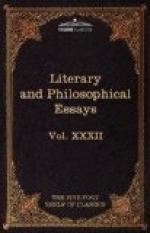earlier version than that which served as a model
for Chretien de Troyes. It is also to be remarked
that, even in Parceval, the mystical idea is not as
yet completely developed, that the trouvere seems
to treat this strange theme as a narrative which he
has found already complete, and the meaning of which
he can scarcely guess. The motive that sets Parceval
a-field in the French romance, as well as in the Welsh
version, is a family motive; he seeks the Holy Grail
as a talisman to cure his uncle the Fisherman-King,
in such a way that the religious idea is still subordinated
to the profane intention. In the German version,
on the other hand, full as it is of mysticism and
theology, the Grail has a temple and priests.
Parsifal, who has become a purely ecclesiastical hero,
reaches the dignity of King of the Grail by his religious
enthusiasm and his chastity. [Footnote: It is
indeed remarkable that all the Breton heroes in their
last transformation are at once gallant and devout.
One of the most celebrated ladies of Arthur’s
court, Luned, becomes a saint and a martyr for her
chastity, her festival being celebrated on August
1st. She it is who figures in the French romances
under the name of Lunette. See Lady Guest, vol.
i., pp. 113, 114.] Finally, the prose versions, more
modern still, sharply distinguish the two chivalries,
the one earthly, the other mystical. In them
Parceval becomes the model of the devout knight.
This was the last of the metamorphoses which that
all-powerful enchantress called the human imagination
made him undergo; and it was only right that, after
having gone through so many dangers, he should don
a monkish frock, wherein to take his rest after his
life of adventure.
V.
When we seek to determine the precise moment in the
history of the Celtic races at which we ought to place
ourselves in order to appreciate their genius in its
entirety, we find ourselves led back to the sixth
century of our era. Races have nearly always a
predestined hour at which, passing from simplicity
to reflection, they bring forth to the light of day,
for the first time, all the treasures of their nature.
For the Celtic races the poetic moment of awakening
and primal activity was the sixth century. Christianity,
still young amongst them, has not completely stifled
the national cult; the religion of the Druids defends
itself in its schools and holy places; warfare against
the foreigner, without which a people never achieves
a full consciousness of itself, attains its highest
degree of spirit. It is the epoch of all the heroes
of enduring fame, of all the characteristic saints
of the Breton Church; finally, it is the great age
of bardic literature, illustrious by the names of
Taliessin, of Aneurin, of Liwarc’h Hen.




